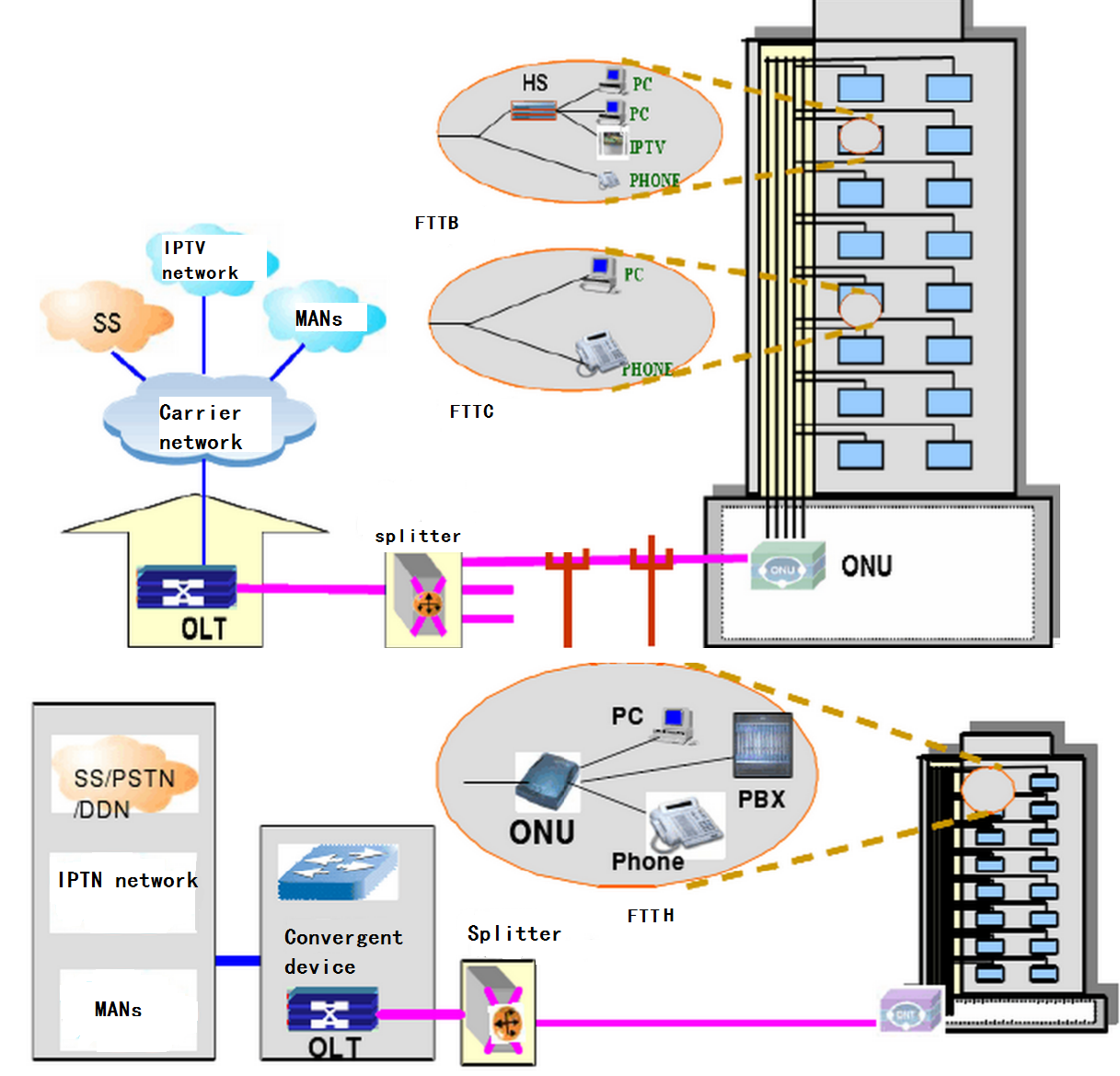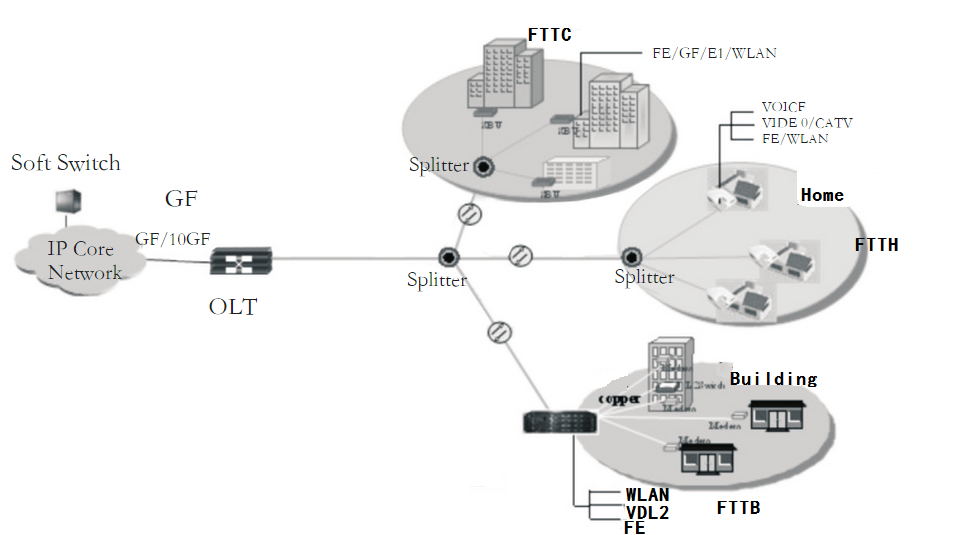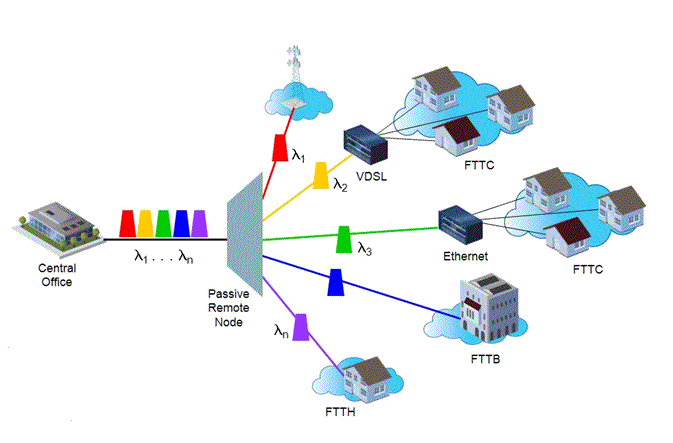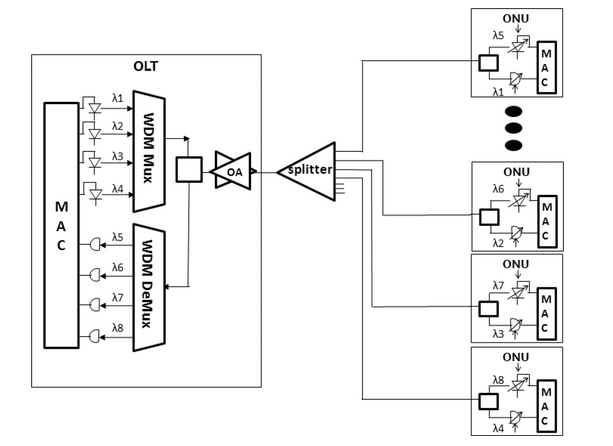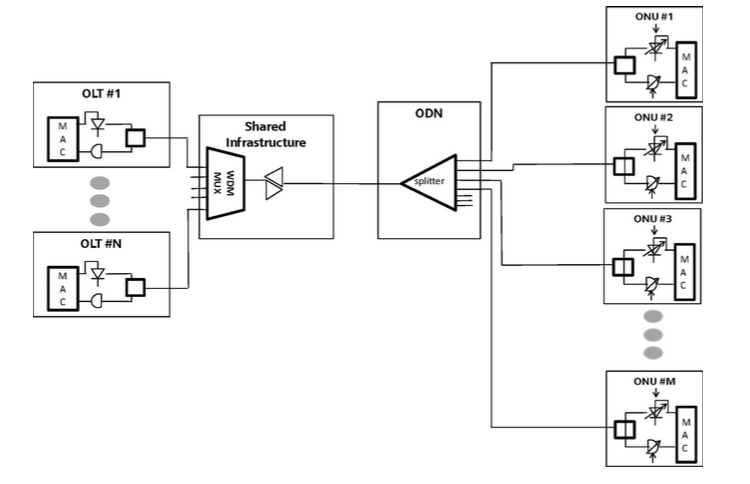Time and Wavelength Division Multiplexed Passive Optical Network (TWDM-PON) technology is the telecommunications industry’s chosen solution for implementing NG-PON2, the next-generation fiber access technology. For network operators, TWDM-PON opens up new avenues toward increased revenue, reduced cost and lower risk.
Operators are using Gigabit Passive Optical Network (GPON) technology to extend fiber access to consumers. GPON will satisfy the bandwidth needs of residential customers for years to come. But to get the most from their fiber networks, operators need to go beyond the capabilities of GPON and find new ways to monetize and maximize their fiber infrastructure investments.
Many operators want to have one flexible network that can support many revenue-generating services, make efficient use of existing assets, and decrease the cost involved in deploying ultra-broadband on a large scale.
TWDM focuses on all facets of this goal. Currently being standardized by the Full Service Access Network (FSAN) and International Telecommunication Union (ITU), TWDM offers an efficient upgrade path for operators that currently invest in GPON infrastructure.
FSAN and ITU envisage two phases for fiber network evolution: NG-PON1 (medium term) and NG-PON2 (long term). NG-PON1 is based on XG-PON1 technology. It offers 10Gbps in downstream and 2.5Gbps in upstream. While available for some time, the XG-PON1 technology has generated little traction in the market. There is limited near-or medium-term demand for 10Gbps residential service that will justify investment in new technology. Meanwhile, emerging technologies offer capabilities beyond higher speeds, so the market focus is shifting to NG-PON2.
For NG-PON2, FSAN evaluated several solutions. Three main contenders emerged:
- TDM evolution is conceptually similar to current PON systems, using much faster electronics and optics. It supports very efficient bandwidth sharing between users. But it requires every ONT to operate at the full 40Gbps line rate, a rate that far exceeds the foreseeable needs of individual users. FSAN dropped TDM-PON from consideration because of high costs and uncertainly associated with some challenges, such as resolving the problem of chromatic dispersion for very high line rates.
- Dense Wavelength-Division Multiplexing PON (DWDM-PON) supports many wavelengths on one fiber. It offers each user on the PON a dedicated wavelength with 1Gbps symmetrical bandwidth per user (10Gbps in the future). Ultimately, FSAN discounted DWDM-PON for residential market use because of its high cost, its inability to support bandwidth sharing between users, and because of the operational complexity involved in terminating and managing one wavelength per user. However, DWDM-PON has potential for niche applications: a DWDM wavelength can be overlaid on GPON to support applications like mobile fronthaul with a fixed constant bandwidth. The annex to the proposed ITU standard describes this special DWDM use case, which is also called point-to-point WDM.
- Time Wavelength Division Multiplexing PON (TWDM-PON) provides four or more wavelengths per fiber, each of which is capable of delivering symmetrical or asymmetrical bit rates of 2.5 Gbps or 10 Gbps. In 2012, FSAN named TWDM-PON technology as its solution of choice for implementing the NG-PON2 architecture.
Each of the NG-PON2 candidate technologies delivers more capacity or flexibility than current GPON technology. But these improvements come with additional cost. The challenge is to identify the degree of capacity and flexibility that can deliver the target benefits at the lowest possible cost.
DWDM-PON would provide maximum flexibility, although with limited real additional capacity, if each wavelength were individually routed through a fiber cross-connect panel and terminated on discrete optics with discrete fibers. But this flexibility would require up to twice as much CAPEX as current GPON and significantly higher OPEX, in the form of bigger central offices, additional Optical Distribution Frames (ODFs), more operational complexity and greater outside plant impact. Terminating all the wavelengths on an integrated multi-wavelength optical module would reduce costs but remove flexibility. It is therefore difficult to realize the target benefits with DWDM.
By contrast, TWDM allows for higher bandwidth (up to 10Gbps for any user with a total of 40Gbps) and optimal flexibility relative to bandwidth per user, fiber management, service convergence and resource sharing. These improvements come at 30% less CAPEX and with less operational complexity than DWDM. In effect, TWDM optimally combines the benefits of TDM with the benefits of DWDM systems.
The increased bandwidth capacity and flexibility of TWDM-PON opens up a new range of possibilities for fiber networks. For example:
- TWDM can supply, manage and evolve to the right (or best-fitting) bandwidth for different services—for instance, high-bandwidth symmetrical for business or high-bandwidth asymmetrical for mobile backhaul. It can also support the convergence of more services and users on the same infrastructure. These capabilities will bring CAPEX savings and additional revenue.
- TWDM-PON adds flexibility by supporting the overlay of multiple services, user groups or organizations on the same fiber. For example, an operator can simplify its operations by using dedicated wavelengths to isolate applications provided by its different business divisions, as shown in the figure below. TWDM-PON allows different wavelengths to be allocated to different services
 .
. - TWDM-PON can accelerate the process of bringing more bandwidth to more users. Increasingly, operators are deploying deep fiber micro-nodes so that they can quickly and cost-efficiently cover more users. These deployments demand high-capacity backhaul. As operators add more micro-nodes, the need for TWDM will surge.
- TWDM-PON enables operators to add flexibility to the customer experience by letting users share the unused common part of bandwidth capacity. For example, an operator could guarantee that 1 Gbps of bandwidth will always be available to all users. Using TWDM-PON, it could allow users to burst above their assigned bandwidth up to 10Gbps to accelerate actions such as downloading HD movies or backing up data to cloud storage.
- With TWDM, different wavelengths can be assigned to different operators. This flexibility will facilitate co-investment in common infrastructure, encourage investment and promote sharing of cost and risk.
One of the key requirements for NG-PON2 is to preserve operators’ current PON investments and allow them to reuse their most expensive component: the outside plant. TWDM-PON addresses this requirement in three key ways:
- GPON compatibility: TWDM-PON can coexist with, and expand on, current GPON deployments. This coexistence ensures that operators’ fiber investments will keep providing value in the long term.
- Zero outside plant impact: TWDM-PON typically has no cost or operational impact on existing passive components, including the outside plant. As part of this no-impact approach, TWDM-PON uses the same splitters to simplify fiber management, facilitate tuning and maximize compatibility with network components and end-user equipment.
- Easy introduction: TWDM-PON can be introduced smoothly and gradually into existing Fiber To The X (FTTX) deployments. Although integrated multi-wavelength solutions are feasible, some operators may find it easier to start with one wavelength and add more as bandwidth demand grows. Upgrades can be introduced on a fiber-by-fiber basis. They are as simple as adding and configuring new cards at the central office.
TWDM-PON promises to reduce cost and risk by promoting efficient operations. Specifically, it supports wavelength management techniques that can allow operators to move end users from one wavelength to another to rebalance bandwidth, reconnect users to other operators, or decrease downtime during software upgrades. These techniques can help operators forgo expensive truck rolls and in-field fiber reconnections in favor of efficiently reassigning users to specific wavelengths from the central office.
Co-investment offers additional opportunities to reduce cost and risk. TWDM-PON brings successful co-investment within reach by providing an environment in which several operators can effectively share a common fiber infrastructure. With TWDM-PON, individual wavelengths can be associated with and controlled by different operators. Each co-investor benefits from lower capital and maintenance costs, added flexibility to support new services, and new opportunities to establish partnerships and business models.
Open, government-owned fiber networks can also provide opportunities to reduce cost and risk. TWDM-PON permits each operator to use one (or more) wavelengths on the common PON, deployed on either common or separate central office equipment. With their own wavelengths, operators gain the flexibility and independence to offer, manage and upgrade quality of service according to their business priorities.
Operators need efficient solutions that can help them capitalize on the potential and benefits of TWDM-PON. Areas requiring technical enablers and optimization include wavelength tuning, optical signal amplification and scalability.
To simplify operations, all TWDM ONTs must be colorless. The ONT transceiver must be able to tune to the correct wavelengths in upstream and downstream during end-user provisioning.
Operators can use a variety of techniques to control the wavelength in the upstream direction from the ONT to the OLT. Temperature is the primary parameter of control. For example, thermo-electric controlled lasers can use heating and cooling to accurately set the wavelength. These lasers are available today and can be used in the ONT, but they are expensive.
A heat-only laser could provide a more cost-effective and power-efficient alternative for addressing the needs of the mass market. However, a heat-only approach can only set the laser to wavelengths that correspond to the ambient temperature or above—never below. Therefore, a cyclic Wavelength Multiplexer (WM) must be used at the OLT to route sets of wavelengths, rather than individual wavelengths, to each OLT port. In this way, the laser can be heated above ambient temperature until its wavelength is part of a given wavelength set associated with the destination OLT port. The wavelength sets are analogous to the sets of piano notes with the same name (i.e. “C”, “D”, “E” etc.) and which repeat cyclically at every octave. This results in a simple and low-cost tuning scheme.
In the long-term, it is hoped that photonic integrated circuits will provide other economical solutions to wavelength control.
In the downstream direction, thermo-controlled thin-film filters can be integrated into the ONT receiver to allow tuning. Photonic integrated circuits may provide a future solution.
At the OLT side, thermoelectric-controlled lasers can accurately hold the downstream wavelengths at the correct wavelength. The upstream wavelengths are routed to the correct OLT receiver by way of a WM, using either Thin-Film Filter (TFF) technology or Arrayed Waveguide Gratings (AWGs).
To transmit higher bit rates with a low error rate, it is necessary to improve the sensitivity of the receivers or increase the level of the received signal. Amplification is needed to transmit these higher-rate optical signals through existing fiber networks, which have a fixed attenuation. The need for amplification is even greater given that NG-PON2 is simultaneously targeting an increased split ratio, greater fiber distances and higher speeds.
Some amplification technologies can be used in both the upstream and downstream directions. These include semiconductor optical amplifiers (SOA) and Erbium Doped Fiber Amplifiers (EDFA). With SOAs, the optimal amplifier location is immediately after the laser in the downstream direction and before the wavelength demux in the upstream direction. All of these components are typically located in the central office.
Operators will need to choose the equipment growth and fiber evolution strategy that best addresses their business needs. For many, the key decision will be whether to adopt a pay-as-you-grow strategy with modular optical components or deploy a fully integrated solution in anticipation of future demand. Others will need to decide whether it makes more business and operational sense to go it alone or embrace a co-investment or network sharing strategy.
Most technical issues can be solved with solutions and advice from knowledgeable vendors. Vendors can also help with business issues, but operators will ultimately need to choose the strategies that best align with their business goals.
Today’s GPON-based networks are bringing fundamental change to many different industry sectors. However, GPON is tapping a fraction of fiber’s potential. New technologies like TWDM will unlock this potential by adding capacity and flexibility. These improvements will help operators generate more revenue by converging multiple services onto one fiber. They will help operators lower cost by increasing operational efficiency and providing access to viable co-investment options. TWDM will also help operators preserve their existing fiber investments: The upgrade path to TWDM uses the same fiber and passive components as current GPON networks and simply overlays new active components.
From Alcatel-Lucent

